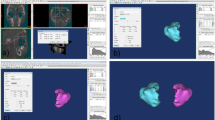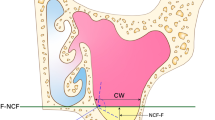Abstract
Aim
Sinus maxillaris is an important anatomical formation in many branches of dentistry due to its proximity to the field of work. Various methods have been used in literature to measure the maxillary sinus volume (MSV) such as cadavers, stereology, two-dimensional conventional radiographs, computed tomography (CT), magnetic resonance imaging (MRI). The aim of this study is to evaluate the change of maxillary sinus volume according to age and gender with MIMICS 19.0 (Materialise HQ Technologielaan, Leuven, Belgium) which is one of three-dimensional modeling software.
Materials and methods
This study was performed in 200 patients selected by a retrospective review of the archives of the Dicle University, Faculty of Dentistry, Department of Oral and Maxillofacial Radiology. Patients were divided into five age groups (18–24 years, 25–34 years, 35–44 years, 45–54 years, and ≥ 55 years) and by sex. Cone-beam computed tomography (CBCT) images of the patients were transferred to the MIMICS software and the MSV was measured. All statistical analyses were performed using the SPSS (Statistical Package for Social Sciences, version 21) software.
Results
There was no statistically significant difference between the right and left maxillary sinus volume according to the findings obtained from our study, and maxillary sinus volume in males was found to be significantly higher than that of females. Another finding of our study is that the maxillary sinus volume decreases with age increase. Especially it was also found that the sinus volume in males in the 18–24 age group was statistically significantly higher than females.
Conclusion
Consequently, maxillary sinus volume measurements can be made on CT, CBCT, MRI scans using reconstruction software.

Similar content being viewed by others
References
Eggesbø HB (2006) Radiological imaging of inflammatory lesions in the nasal cavity and paranasal sinuses. Eur Radiol 16(4):872–878. https://doi.org/10.1007/s00330-005-0068-2
Li L, Yang J, Chu Y et al (2016) A novel augmented reality navigation system for endoscopic sinus and skull base surgery: a feasibility study. PLoS One 11(1):1–17. https://doi.org/10.1371/journal.pone.0146996
Büyükkurt MC, Tozoğlu S, Yavuz MS, Aras MH (2010) Simulation of sinus floor augmentation with symphysis bone graft using three-dimensional computerized tomography. Int J Oral Maxillofac Surg 39(8):788–792. https://doi.org/10.1016/j.ijom.2010.04.d005
Favato MN, Vidigal BC, Cosso MG et al (2015) Impact of human maxillary sinus volume on grafts dimensional changes used in maxillary sinus augmentation: a multislice tomographic study. Clin Oral Implants Res 26(12):1450–1455. https://doi.org/10.1111/clr.12488
Phothikhun S, Suphanantachat S, Chuenchompoonut V, Nisapakultorn K (2012) Cone-beam computed tomographic evidence of the association between periodontal bone loss and mucosal thickening of the maxillary sinus. J Periodontol 83(5):557–564. https://doi.org/10.1902/jop.2011.110376
Teke HY, Duran S, Cantürk N, Cantürk G (2007) Determination of gender by measuring the size of the maxillary sinuses in computerized tomography scans. Surg Radiol Anat 29(1):9–13. https://doi.org/10.1007/s00276-006-0157-1
Değermenci M (2014) Çocuklarda sinüs maxillaris’in yaşa bağlı olarak gelişimi. Dissertation, University of Erciyes
Emirzeoğlu M, Şahin B, Bilgiç S, Çelebi M, Uzun A (2007) Volumetric evaluation of the paranasal sinuses in normal subjects using computer tomography images: a stereological study. Auris Nasus Larynx 34(2):191–195. https://doi.org/10.1016/j.anl.2006.09.003
Kanthem RK, Guttikonda VR, Yeluri S, Kumari G (2015) Sex determination using maxillary sinus. J Forensic Dent Sci 7(2):163–167. https://doi.org/10.4103/0975-1475.154595
Uchida Y, Goto M, Katsuki T, Akiyoshi T (1998) A cadaveric study of maxillary sinus size as an aid in bone grafting of the maxillary sinus floor. J Oral Maxillofac Surg 56(10):1158–1163. (PMID:9766541)
Sánchez Fernández JM, Anta Escuredo JA, Sanchez Del Rey A et al (2000) Morphometric study of the paranasal sinuses in normal and pathological conditions. Acta Otolaryngol 120(2):273–278. (PMID: 11603789)
Mimics 18.0 (2015) Training guide. Materialise. https://www.materialise.com/en/medical/electronic-instructions-for-use
Stutzki M, Jahns E, Mandapathil MM et al (2015) Indications of cone beam CT in head and neck imaging. Acta Otolaryngol 135(12):1337–1343. https://doi.org/10.3109/00016489.2015.1076172
Oz U, Orhan K, Abe N (2011) Comparison of linear and angular measurements using two-dimensional conventional methods and three-dimensional cone beam CT images reconstructed from a volumetric rendering program in vivo. Dentomaxillofac Radiol 40(8):492–500. https://doi.org/10.1259/dmfr/15644321
Mozzo P, Procacci C, Tacconi A et al (1998) A new volumetric CT machine for dental imaging based on the cone-beam technique: preliminary results. Eur Radiol 8:1558–1564. (PMID: 9866761)
Scarfe WC, Farman AG, Sukovic P (2006) Clinical applications of cone-beam computed tomography in dental practice. J Can Dent Assoc 72(1):75–80. (PMID: 16480609)
Scarfe WC, Farman AG (2008) What is cone-beam CT and how does it work? Dent Clin North Am 52:707–730. https://doi.org/10.1016/j.cden.2008.05.005
Szabo BT, Aksoy S, Repassy G et al (2017) Comparison of hand and semiautomatic tracing methods for creating maxillofacial artificial organs using sequences of computed tomography (CT) and cone beam computed tomography (CBCT) images. Int J Artif Organs Jun 9(6):307–312. https://doi.org/10.5301/ijao.5000580 40) .
Ludlow JB, Ivanovic M (2008) Comparative dosimetry of dental CBCT devices and 64-slice CT for oral and maxillofacial radiology. Oral Surg Oral Med Oral Pathol Oral Radiol Endod 106:106–114. https://doi.org/10.1016/j.tripleo.2008.03.018
Panou E, Motro M, Ateş M et al (2013) Dimensional changes of maxillary sinuses and pharyngeal airway in Class III patients undergoing bimaxillary orthognathic surgery. Angle Orthod 83(5):824–831. https://doi.org/10.2319/100212-777.1
Motro M (2011) Hızlı üst çene genişletmesini takiben ve bir yıllık retansiyon dönemi sonrası maksiller sinüslerde meydana gelen değişikliklerin 3 boyutlu olarak İncelenmesi. Dissertation, University of Marmara
Cho SH, Kim TH, Kim KR et al (2010) Factors for maxillary sinus volume and craniofacial anatomical features in adults with chronic rhinosinusitis. Arch Otolaryngol Head Neck Surg 136(6):610–615. https://doi.org/10.1001/archoto.2010.75
Möhlhenrich SC, Heussen N, Peters F et al (2015) Is the maxillary sinus really suitable in sex determination? A three-dimensional analysis of maxillary sinus volume and surface depending on sex and dentition. J Craniofac Surg 26(8):e723–e726. https://doi.org/10.1097/SCS.0000000000002226
Orhan I, Örmeci T, Aydın S et al (2014) Morphometric analysis of the maxillary sinus in patients with nasal septum deviation. Eur Arch Otorhinolaryngol 271(4):727–732. https://doi.org/10.1007/s00405-013-2617-7
Tiftik M (2011) Bilateral nazal polipi olan ve olmayan hastaların maksiller sinüs hacim ve posterolateral duvar kemik kalınlıklarının bilgisayarlı tomografi ile değerlendirilmesi. Dissertation, University of Fatih
Kılıç C, Kamburoğlu K, Yüksel SP, Özen T (2010) An assessment of the relationship between the maxillary sinus floor and the maxillary posterior teeth root tips using dental cone-beam computerized tomography. Eur J Dent 4(4):462–467. (PMCID: PMC294874. PMID: 20922167)
Park IH, Song JS, Choi H, Kim TH et al (2010) Volumetric study in the development of paranasal sinuses by CT imaging in Asian: a pilot study. Int J Pediatr Otorhinolaryngol 74(12):1347–1350. https://doi.org/10.1016/j.ijporl.2010.08.018
Orhan İ, Soylu E, Altın G, Yılmaz F et al (2014) Paranazal sinüs anatomik varyasyonlarının bilgisayarlı tomografi ile analizi. Abant Med J 3(2):145–149. https://doi.org/10.5505/abantmedj.2014.84803
Ariji Y, Kuroki T, Moriguchi S, Ariji E, Kanda S (1994) Age changes in the volume of the human maxillary sinus: a study using computed tomography. Dentomaxillofac Radiol 23(3):163–168. https://doi.org/10.1259/dmfr.23.3.7835518
Takahashi Y, Watanabe T, Iimura A, Takahashi O (2016) A study of the maxillary sinus volume in elderly persons using japanese cadavers. Okajimas Folia Anat Jpn 93(1):21–27
Jun BC, Song SW, Park CS, Lee DH et al (2005) The analysis of maxillary sinus aeration according to aging process; volume assessment by 3-dimensional reconstruction by high-resolutional CT scanning. Otolaryngol Head Neck Surg 132(3):429–434. https://doi.org/10.1016/j.otohns.2004.11.012
Aksoy S (2013) Konik ışınlı komputerize tomografi kullanilarak üç boyutlu olarak paranasal sinüs ve varyasyonlarinin üst havayolu anatomisi ile birlikte incelenmesi. Dissertation, Near East University
Demir UL, Akca ME, Ozpar R et al (2015) Anatomical correlation between existence of concha bullosa and maxillary sinus volume. Surg Radiol Anat 37(9):1093–1098. https://doi.org/10.1007/s00276-015-1459-y
Prabhat M, Rai S, Kaur M, Prabhat K et al (2016) Computed tomography based forensic gender determination by measuring the size and volume of the maxillary sinuses. J Forensic Dent Sci 8(1):40–46. https://doi.org/10.4103/0975-1475.176950
Sahlstrand-Johnson P, Jannert M, Strömbeck A, Abul-Kasim K (2011) Computed tomography measurements of different dimensions of maxillary and frontal sinuses. BMC Med Imaging. https://doi.org/10.1186/1471-2342-11-8
Anagnostopoulou S, Venieratos D, Spyropoulos N (1991) Classification of human maxillar sinuses according to their geometric features. Anat Anz 173(3):121–130. (PMID: 1789468)
SEDENTEXCT GDP (2012) Radiation protection No 172. Cone beam CT for dental and maxillofacial radiology. Evidence based guidelines. European Comminssion Directorate-General for Energy, Luxembourg. http://www.sedentexct.eu/content/guidelines-cbct-dental-and-maxillofacial-radiology
Orhan K (2012) Diş hekimliğinde konik ışınlı komputerize tomografinin (KIKT) yeri ve önemi. Yeditepe J Dent 3:6–17
Aktuna Belgin C, Adiguzel O, Bud M, Colak M, Akkus Z (2017) Mandibular buccal bone thickness in southeastern anatolian people: a cone-beam computed tomography study. Int Dent Res 7(1):6–12. https://doi.org/10.5577/intdentres.2017.vol7.no1.2
Ten Dam E, Korsten-Meijer AG, Schepers RH et al (2015) Calculating nasoseptal flap dimensions: a cadaveric study using cone beam computed tomography. Eur Arch Otorhinolaryngol 272(9):2371–2379. https://doi.org/10.1007/s00405-014-3353-3
Güldner C, Diogo I, Bernd E et al (2017) Visualization of anatomy in normal and pathologic middle ears by cone beam CT. Eur Arch Otorhinolaryngol 274(2):737–742. https://doi.org/10.1007/s00405-016-4345-2
Güldner C, Ningo A, Voigt J et al (2013) Potential of dosage reduction in cone-beam-computed tomography (CBCT) for radiological diagnostics of the paranasal sinuses. Eur Arch Otorhinolaryngol 270(4):1307–1315. https://doi.org/10.1007/s00405-012-2177-2
Li G (2013) Patient radiation dose and protection from cone-beam computed tomography. Imaging Sci Dent 43(2):63–69. https://doi.org/10.5624/isd.2013.43.2.63
Torres MG, Campos PS, Segundo NP et al (2012) Accuracy of linear measurements in cone beam computed tomography with different voxel sizes. Implant Dent 21(2):150–155. https://doi.org/10.1097/ID.0b013e31824bf93c
Sherrard JF, Rossouw PE, Benson BW et al (2010) Accuracy and reliability of tooth and root lengths measured on cone-beam computed tomographs. Am J Orthod Dentofacial Orthop 137(4):S100–S108. https://doi.org/10.1016/j.ajodo.2009.03.040
Weissheimer A, de Menezes LM, Sameshima GT et al (2012) Imaging software accuracy for 3-dimensional analysis of the upper airway. Am J Orthod Dentofacial Orthop 142(6):801–813. https://doi.org/10.1016/j.ajodo.2012.07.015
Thayyil S, Schievano S, Robertson NJ et al (2009) A semi-automated method for non-invasive internal organ weight estimation by post-mortem magnetic resonance imaging in fetuses, newborns and children. Eur J Radiol 72(2):321–326. https://doi.org/10.1016/j.ejrad.2008.07.013
Acknowledgements
This work supported by the Dicle University Scientific Research Projects Coordination (Projects No: DİŞ.17.015).
Author information
Authors and Affiliations
Corresponding author
Ethics declarations
Conflict of interest
All authors declare that they have no conflict of interest.
Ethical statements
The Ethics Committee of the Dicle University Dentistry Faculty approved this retrospective study. All procedures followed were in accordance with the ethical standards of the responsible committee on human experimentation (institutional and national) and with the Helsinki Declaration of 1964 and later versions. Informed consent was obtained from all patients for being included in the study.
Additional information
Publisher’s Note
Springer Nature remains neutral with regard to jurisdictional claims in published maps and institutional affiliations.
Rights and permissions
About this article
Cite this article
Aktuna Belgin, C., Colak, M., Adiguzel, O. et al. Three-dimensional evaluation of maxillary sinus volume in different age and sex groups using CBCT. Eur Arch Otorhinolaryngol 276, 1493–1499 (2019). https://doi.org/10.1007/s00405-019-05383-y
Received:
Accepted:
Published:
Issue Date:
DOI: https://doi.org/10.1007/s00405-019-05383-y




